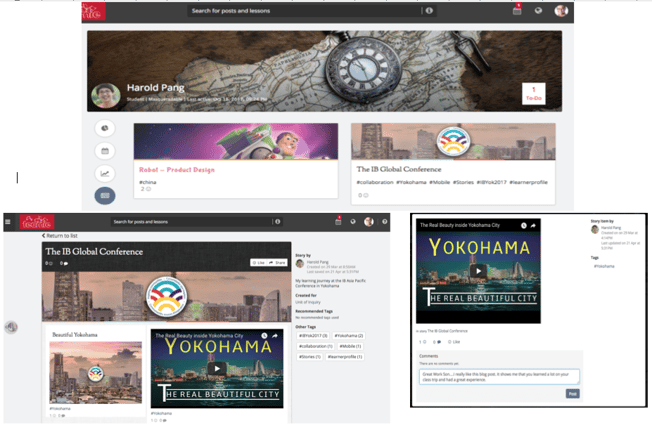When you build a strong connection between home and school, everybody wins. Research shows that when these two worlds are properly connected, students will do better in school, teachers gain self assurance through parental feedback, and parents are at ease, become empowered and more invested in their child's education. Furthermore, research shows that students who have parents that are actively involved in their education tend to have better attendance rates, better social skills, and increased graduation rates.
With the busy lives of the modern world you would think that creating or maintaining this connection is getting more difficult but fortunately technology is the saving grace and tool which is allowing schools to build this connection stronger than ever. Technology offers teachers a variety of ways to build a connection between home and school. Choosing the proper LMS which gives parent accounts that offer a portal into the child’s day to day learning activities, and other participatory and insight components, can be the ultimate tool in building and maintaining this strong home-school connection.
“How was School?”
“I dunno, okay”
“What did you learn?”
“I dunno, stuff”
“What’s your homework?”
“Umm, I don’t think I got any”
This is how I remember many of my post school pre-dinner discussions as a child. Frustrating for my parents? I imagine so. There were weekly or monthly newsletters which updated parents on major school events, carrying old or irrelevant news, and that’s if they made it home at all! We used an agenda where homework was recorded and checked dutifully by the teacher. As a student who performed this task and later as a teacher who was required to carry it through with their own class, it was a monotonous and frustrating task for all, which ate up too much valuable class time. But those are memories from a bygone era (or could and should be) and now parents can be given a transparency and insight into their child’s learning, progress and school life beyond that which was ever possible before; beyond that they can have it in real time, anywhere and at anytime.
Let’s look at both the the tools offered by LMS, with structured parent permissions, which offers parents unprecedented insight into their child’s learning as well as look at some techniques to leverage the LMS’s capabilities that moves parent involvement beyond that of being a passive recipient of information on their child’s learning to that of being an active participant in the school community and day to day learning happening in the classroom and done by their child.
Making Parents Happy With Your Learning Management System
1. Parent Accounts and Parent Permissions
For many families today it’s difficult to manage work schedules and find time to play an active role in the education process. An LMS that helps teachers involve every parent, regardless of career demands, travel and other complicating factors is becoming a necessary resource for schools (especially schools where parents are paying a tuition). Too often parents are asked to check a public website for school announcements, a second system for grades & attendance, and yet other systems for homework and class updates. An LMS should bring this all together so through a single log-in parents enter their own portal where they can see announcements from the school, class updates and resources for every class of each child, and a single, consolidated calendar showing all school events, class activities, homework and assessments that are coming up for all their children. This view could also give real time insights on their children’s progress and information on their children’s recent activity (participation) in the virtual learning environment. With this resource, parents no longer need to physically visit schools to participate in learning conversations or wait for a report card to inform them of their child’s progress and areas in need of intervention and support.
2. Parent Specific Groups and Modules
The LMS should have the flexibility to create modules or learning/communication areas for parents (like classrooms) to get pertinent school information and/or participate in conversations with teachers, administrators and other parents. Beyond conversations, through these groups, schools can share resources like photos and videos of school events and special classroom learning activities, so that parents who are unable to make the event physically can still experience and share with their child. Online discussion threads, and the ability to run polls for quick parental feedback are features which help schools keep a finger on the pulse of the parent community. The ability of your LMS to build multiple groups which parents can participate in will streamline interactions between the school and highly engaged parents while keeping the lines of communication open. Parents greatly appreciate any and all updates, even if they’re brief.
3. Mobile Apps
Of course the proliferation of smartphones is a major development in how we communicate and access information in our daily lives, ‘on average, people in the United States across all age groups check their phones 46 times per day’¹. Mobile apps and notifications make it possible for teachers and schools to stay connected even with parents who must frequently travel for their work or may be posted away from the home but still deeply desire to be active participants in their child’s learning. A native app will ensure that parents can access resources like video and documents in a format suited to any device they are on and the resource will be optimized for mobile access. For some parents this anytime, anywhere access is a much appreciated luxury but for many it is becoming more and more a necessity.

4. Student Blog and ePortfolio Access
Student blogs or ePortfolios are excellent ways for parents to experience first hand their child’s learning, what sort of content they are studying and what are their takeaways or reflections on that content. Students love seeing their work on the Internet and adore getting comments from their peers and supervisors. Comments motivate students to write as it gives them an audience that is real and parental participation is as important, if not more important than peers and teachers, especially for younger students. A blog or ePortfolio component to the LMS, where parents can view students work and even comment and like artifacts, opens up a great tool for parents to offer encouragement and feedback. There are many stand-alone learning blog or ePortfolio solutions available to schools and students. A student may have various learning blogs or ePortfolios through which they document their learning but in many cases parents don’t know these exist, have difficulty accessing them or simply fall out of the practice of regularly checking these. Parent access to view student blogs and ePortfolios directly through the LMS and their parent accounts makes it seamless and easy for parents to view student work, understand and have conversations around the content their children are engaging with in classes, link it with their child’s learning journey and offer encouragement through comments and likes.

(From the parent permission view see a catalogue view of all the child’s blog and ePortfolio. They can select one to view it and even like and comment on the whole blog or individual learning artifacts within.)
5. Building a Community of Parent Participation
Teachers often see greater success and a larger response from the parent community when classroom resources and homework materials are posted and made as easily accessible as possible. Most parents have always wanted to participate in student learning but often have been left in the dark, the LMS acts as a light, informing and directing parents to the work and resources they can be helping their child with. Rather than make your parents simply recipients of information through the LMS strive to make them active participants and give them some agency to create and interact. Engage parents by posting polls, recognizing various student news and achievements, give opportunity to parents to contribute to your podcasts, newsletters, blog, or vodcasts. Especially for younger learners, but not exclusively, use your LMS to involve parents in coursework and homework. Assign parent/child activities as homework and invite parents on occasion to participate in classroom virtual learning environments.
Schools can have parents contribute or volunteer, in leadership and/or content creation roles in LMS class or grade parent groups, these parents could initiate and monitor discussions, run polls, submit ideas, and even generate quizzes and lessons for other parents. Schools can host a series of workshops for parents on how to use and eventually maximise the potential of your LMS. Remember that not all parents are fluent English speakers, so if your LMS can offer an interface in other languages, that’s a big advantage in sustaining engagement even across language barriers. Finally, if you are going to be giving parents more of a participatory role on your platform, it may be a good idea to get parents to sign your Acceptable Use/ Responsible Use Policy.
Final Thoughts
Rather than simply providing a space for students and parents to login and download what they need, the LMS should create a space that encourages the sharing of ideas and engaging with others. More and more LMS platforms are adopting features often seen on popular social media sites, such as Facebook. Creating a cohesive community of teachers, administrators, students and parents for sharing information and understanding what is happening in the classroom is a goal for most schools in leveraging their LMS and inevitably lead to greater student success. The use of technology, and the selection of the right LMS based on a school’s needs, is foundational to supporting and managing school resources, teacher success, student learning, and parental expectations. The result is an environment that encourages collaboration, transparency and engaging conversations among parents and educators, and therefore strengthening home-to-school connections. Let the technology bring people closer and foster stronger relationships.
¹https://www.pastemagazine.com/articles/2017/04/unplugged-smartphones-are-part-of-our-daily-routin.html
Planning to roll out Learning Technologies to enhance learning pedagogy?
Download this white paper that includes 24 Best Practices for implementing an LMS.



Leave a Reply